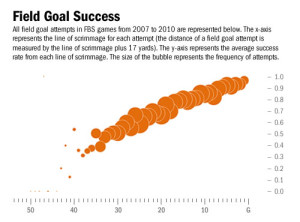Importance of Charting
 Similar to my blog last week, we will focus on the question, “why are kickers important?” this week. I have heard it a million times throughout my career, “kickers aren’t real football players.”
Similar to my blog last week, we will focus on the question, “why are kickers important?” this week. I have heard it a million times throughout my career, “kickers aren’t real football players.”
Well that is until you are needed for a crucial kick and/or the game is on the line. The other guys on the team think you have an easy job because all you do is kick during practice and don’t have to run sprints and avoid blocks/tackles.
The truth is you have one of the hardest and most stressful positions on the team. Unlike a QB who may throw an incomplete pass and can come back the next snap and throw another ball, you may only get one field goal attempt in a game, and if something goes wrong, you do not have the opportunity to redeem yourself.
Field Goal Success Rate Vs. Going For It On 4th Down
 A lot of coaches like to go for it on 4th down because they know that a touch down is worth twice as much as a field goal. But you have to play your percentages.
A lot of coaches like to go for it on 4th down because they know that a touch down is worth twice as much as a field goal. But you have to play your percentages.
Now each game situation is different, I understand that. Just for fact sake, here is the breakdown of successful field goals versus success rate on 4th down conversions.
As you can see from the graph on the left, the success of field goals based on distance is very linear (based on FBS vs FBS stats). Ranging from 97% success for a 18 yard field goal, down to 31% for a 55 yard field goal. Now compare this to going for it on 4th down.
- Going for a 4th and 1 has a success rate of 70.1%, which is equivalent to the success of a 35 yard field goal (70%).
- 4th and 2 (56%) vs. a 46 yard field goal (55%).
- 4th and 3 (53%) vs. a 47 yard field goal (51%).
- 4th and 4 (47.5%) vs. a 50 yard field goal (47%)
- 4th and 5 (43.2%) vs. a 51 yard field goal (39%)
- 4th and 6 (36%) vs. a 54 yard field goal (35%)
Much further back and you are out of field goal range, but my point here is you have a much better chance of putting points on the board by kicking a field goal than going for a 4th and short if within field goal range. I also understand that every kicker is different, and these averages are based on D-1 college kickers kicking against D-1 college competition.
Importance of Charting
That being said, this is why charting is so important. You can figure out your percentages by distance, side of the field you are stronger, etc. so your coach knows when to go for it or when to kick a field goal. This knowledge can be the difference in winning a game and losing by a few points.
Breaking It Down
You can break down why kickers are important into a few significant categories…margin of victory, average points per game by a kicker, field goal success vs. 4th down conversion.
 When thinking of the margin of victory coming down to a kicker, you would probably think of a game decided by 3 points or less. With thinking along these lines, games are decided by a kicker in 23.59% of NFL games. That’s pretty significant to think that kickers contribute to almost 25% of wins at the highest level.
When thinking of the margin of victory coming down to a kicker, you would probably think of a game decided by 3 points or less. With thinking along these lines, games are decided by a kicker in 23.59% of NFL games. That’s pretty significant to think that kickers contribute to almost 25% of wins at the highest level.
Not too shabby for someone who isn’t a “real football player.” How many other guys on the team can say they directly contribute to almost 25% of the wins?
BUT what if a kicker kicks more than one field goal in a game?
When considering the total amount of points a kicker contributes per game, their significance is even more important. In 2012, the average points per game (by means of field goal) came to 11 points.
This doesn’t even include extra point attempts. Now compare this to the average total points scored in an NFL game of 22.2 points.
Now, instead of saying a kicker contributes to 25% of NFL wins, it seems kickers are even more important contributing about 50% of the points per game.
